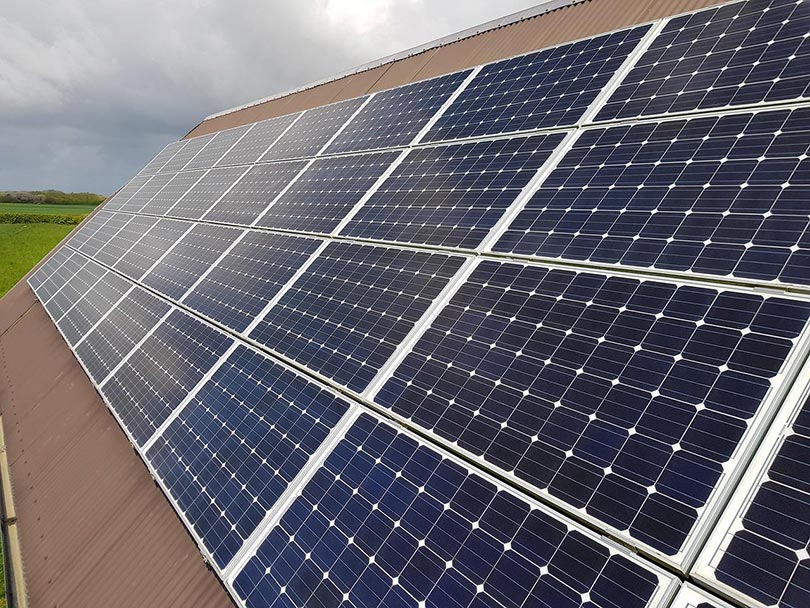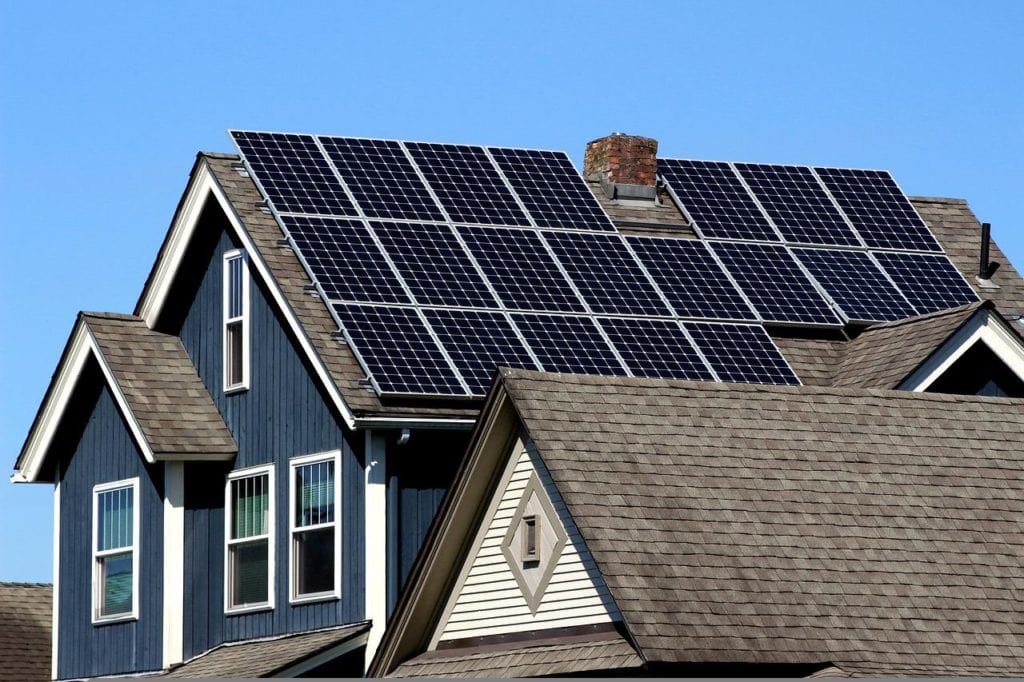Solar Shingles vs Solar Panels: Pros, Cons, Differences, & Lifespan
-
Visnja Radosavljevic
- Last updated:

Many people are looking to become more eco-friendly and save money on their utility bills. To do that, most of them go for solar shingles or solar panels. Both are sustainable, durable, and will help you spend less cash on bills, but do you know everything about their benefits and disadvantages?
Today we will talk about solar shingles and solar panels to see how they compare, and which option would work the best for your household. You’ll be able to see all the necessary details below, so check out the rest of the article and consider which solar option works the best for you.
Hopefully, we will help you make a smart purchase and get the most for your money.
Overview of Solar Shingles
Solar shingles are PV (photovoltaic) and they either replace the existing roof shingles or lay on top of them. They are a great way to lower your utility bills and live a more sustainable life. Besides being eco-friendly, solar shingles are also aesthetically pleasing since they blend into the roof, unlike solar panels, which can sometimes be bulky and look unattractive.
How Do Solar Shingles Work?
Solar shingles are cells that transform the sun’s radiation into the electricity we use while also being a roofing material for your house. They are shingle-shaped and provide excellent structural support for your roof while helping you lower your bills. It’s a perfect combination of clean energy and aesthetically appealing, modern roofing for your home.
People who need a complete roof replacement will benefit the most from installing solar shingles. Although they require higher upfront costs, they will look better than solar panels, and they won’t be visible on the surface of your roof.
Durability and Efficiency
One of the most significant advantages of solar shingles is that they are more durable than solar panels. While panels sit on the roof, shingles represent the roof structure, making them more resilient. They are weather-resistant and fire-resistant, something that solar panels are not.
When it comes to their efficiency, solar shingles are not as effective as solar panels. You cannot adjust solar shingles the way you can adjust solar panels, so you would need to add more shingles on the roof to achieve more energy production. That would mean you’ll need to spend more money on materials, which wouldn’t be convenient.
Size and Materials
The sizes of solar shingles are the same as regular roofing shingles, which are 12” W x 86” L, and their weight per square foot is around 13 pounds. They are very thin, and you would need about 350 tiles to complete a standard solar shingle installation.
Commonly, they are indium gallium selenide tiles, making them thin and flexible. Some manufacturers make them from monocrystalline silicon, although those solar shingles are more expensive. Indium gallium selenide shingles have a 10% to 20% conversion efficiency rate, while monocrystalline silicon shingles’ efficiency rate is higher at 15% to 20% making them cost more.
The Lifespan of Solar Shingles
Like solar panels, solar shingles have a long lifespan, and they commonly last around 20 years. Their longevity can also depend on the manufacturer and the quality of installation. You should check out the different warranties before purchasing solar shingles to ensure you’ll be covered if something happens.
- Sleek design
- Not visible on the roof
- No wiring and no weak spots
- Great for homes that need a roof replacement
- Durable and weather-resistant
- Easy to maintain
- Eco-friendly
- They cannot be set on all existing roofs
- Expensive compared to solar panels
- Limitations in colors and styles
- Higher upfront costs
- Less energy-efficient than standard solar panels
- Still new on the market, so not many companies perform the installation
Overview of Solar Panels
Solar panels are PV modules/panels placed on your roof to collect sunlight and turn it into electricity. They can have various purposes such as providing power for the solar electric system, telecommunication equipment, remote power systems, etc. They are a perfect option for someone who wants to live greener while spending less money on utilities. Solar panels are typically bulkier than solar shingles, but they have other features that make them stand out. Still, as they depend on space, not every home will be able to install enough solar panels needed to produce 100% of the home’s energy requirements.

How Do Solar Panels Work?
Like solar shingles, solar panels also collect the sunlight and convert it into usable energy. They are put together from several solar cells with silicon, phosphorous, and boron layers. Phosphorous layers provide a negative charge, while boron layers provide a positive charge. Unlike solar shingles, solar panels don’t provide structural support to the roof, but they are adjustable, so you can set them up to soak in more sun rays.
The working process of solar panels is called the “Photovoltaic Effect” because solar panels absorb photons that turn into electrical current.
Durability and Efficiency
Solar panels are pretty durable, although not as durable as solar shingles. Their durability depends on their installation and weather. Solar panels can get damaged if there’s wiring that’s not set up properly, and harsh weather conditions could potentially damage them.
When it comes to efficiency, it depends on the mounting position, temperature, and panel material. The technicians need to position them to face the sun as much as possible. Still, the temperature in your environment will also have an impact. Different material panels also have different efficiencies, so some are better than others.

Size and Materials
Typical solar panels are either 60” W x 39” L or 5.4’ L x 3.25’ L, although manufacturers make many variations, and some even create custom-made solar panels. The size hasn’t drastically changed, although the efficiency is much better nowadays.
- Monocrystalline: These are pure silicon solar panels with the highest efficiency standard compared to the other two materials. They commonly have rounded edges and are of dark colors. Their conversion efficiency currently stands at about 22% to 27%.
- Polycrystalline: These are somewhat less efficient than monocrystalline panels, and their conversion efficiency is about 15% to 22%.
- Thin-film: These solar panels have a glass, metal, or plastic covering with fine layers of photovoltaic metal. They are convenient due to their flexibility and low weight. Their conversion efficiency is around 15% to 22%.
The Lifespan of Solar Panels
The average solar panel lifespan is around 25 years. Like solar shingles, they also have warranties, and they depend on the manufacturer, installation, and maintenance to last longer.
- Allow for living off-grid
- Massive savings on utility bills
- Increased property value
- Low costs of maintenance
- Return of the investment in a couple of years
- Power can also be used at night
- Eco-friendly
- High upfront costs
- Sunny weather is required for the best results
- Occasionally unreliable
- Complicated to move
- Materials used to make solar panels can harm the environment
- A lot of roof space needed
Solar Shingles VS Solar Panels – Which Is Best for Me?
Both solar panels and solar shingles sound great, but you are probably still wondering which option will work the best for you. If you’re still indecisive, check out our comparisons to see which solar power method will suit your needs.

Differences Between Solar Shingles and Solar Panels
The first major difference we want to point out is when you should use solar panels and when solar shingles. The list below will provide you with more insight into that.
- When you want to achieve better visual aesthetics for your roof
- When you need a complete roof replacement
- When you want to improve your home value
- When you have enough roof space to install the panels
- When you want faster installation
- When you want a return on your investments in a couple of years
Productivity
When we talk about productivity, solar panels are more productive than solar shingles. Since their placement needs to follow the roof structure, it’s likely that there will be sections where there’s not enough sunlight for the solar shingles to function.
When installing solar panels, the technicians place them in spots that get the most sunlight so you won’t have the same issue you can face with solar shingles.

Maintenance
As far as maintenance goes, solar panels need regular cleaning. That’s because dirt and debris collect on them, and if you don’t clean them, they won’t be able to collect enough energy from the sun. Another thing solar panels maintenance includes is an annual checkup.
Solar shingles don’t need that much maintenance, although you have to clean them from leaves and snow. Even without any other maintenance or checkups, solar shingles will function correctly for a long time.
Price
The last comparison on our list is the price. Although we cannot mention exact numbers since they vary per manufacturer and labor costs, we can say that solar shingles are more expensive than solar panels.
Both solar panels and solar shingles get federal tax incentives that can help you get your invested money back. Still, solar shingles have a slower return on investments, so if you’re looking for something that will pay off quicker, solar panels might be a more reasonable option.
Conclusion
There’s no right or wrong choice when considering purchasing solar panels or solar shingles. The best way to determine which option would suit you better is to compare the price, efficiency, maintenance, productivity, and other aspects that affect these solar power sources. Once you look at all the benefits and disadvantages, you’ll have a clearer view of what works for you.
See also: Solar Panels Roof vs. Ground: Which Is Better?
- “The only solar shingles buying guide you need”
- “Solar shingles: turn your roof a power source”
- “What is a solar panel?”
- “What are solar panels?”
- “Solar panels: are they worth it?”
- “Is solar power worth the investment?”
- “How many solar panels do you need: panel size and output factor”
- “Solar shingles VS solar panels: detailed comparison”
Featured Image Credit: (L) Negro Elkha, Shutterstock | (R) eliseocabrera, Pixabay
Contents

